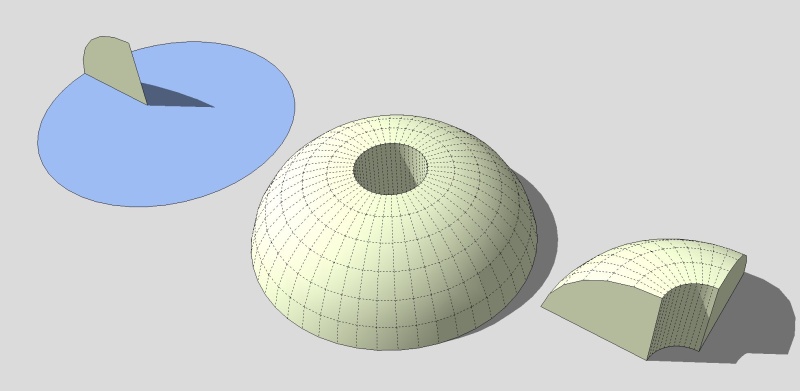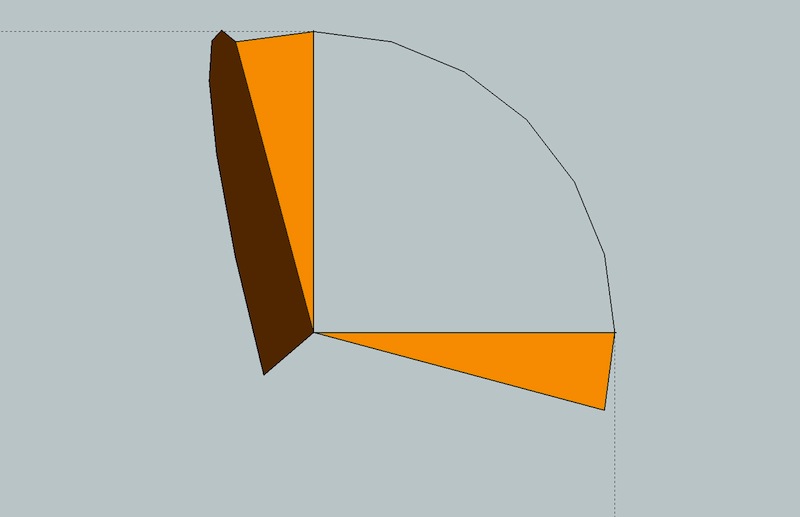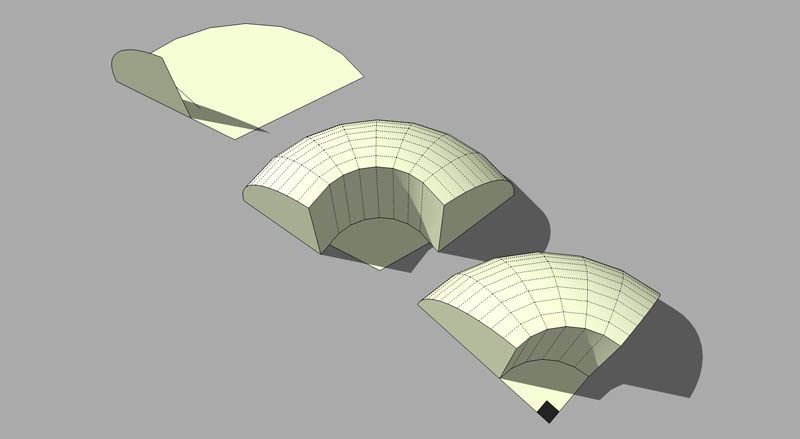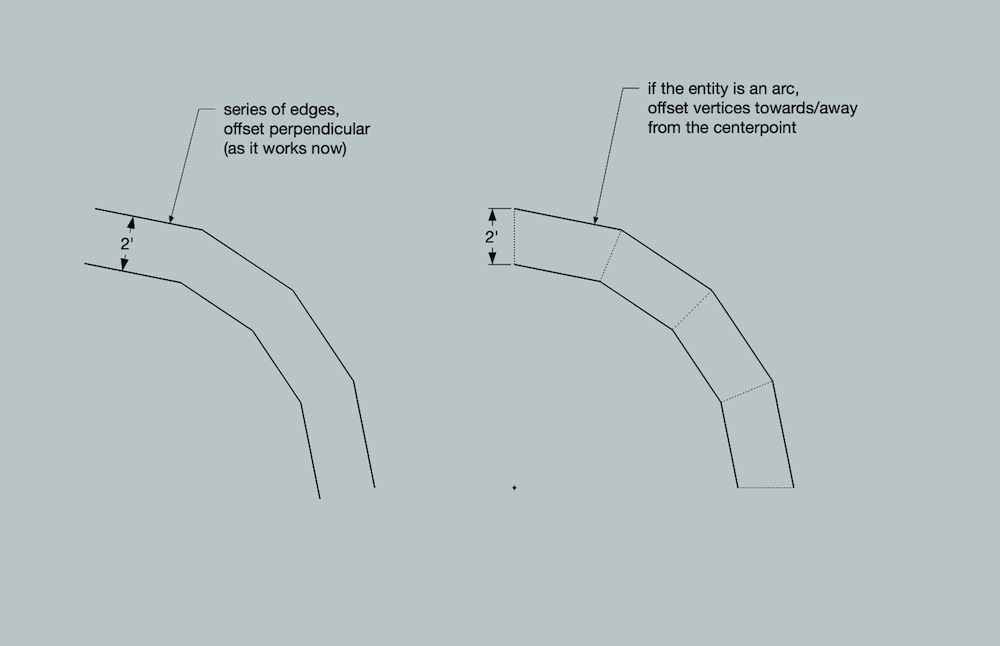Sketchup is Inacurrate???
-
Was it?
You are sometimes (often) a pebble in the shoe, but this remind us we are just humans.
Hang on.
-
So far the only way I have done shapes, like the last shown, was by building them by hand.
That way I am sure there is no weird bulge or any other unexpected result.
It is nowhere stated by the developers that one should not use the follow me tool, at least I did not see any warning.
This is the promise from the Sketchup web site:
@unknownuser said:
Follow Me: Create complex extrusions and lathed forms
You use SketchUp's innovative, do-everything Follow Me tool to create 3D forms by extruding 2D surfaces along predetermined paths. Model a bent pipe by extruding a circle along an L-shaped line. Create a bottle by drawing half of its outline, then using Follow Me to sweep it around a circle. You can even use Follow Me to round off (fillet) edges on things like handrails, furniture and electronic gadgets.
No warnings stating that there are problems and unexpected results.
Edit: oh I just saw Jeff had quoted the above statement already, sorry for the repeat.
-
-
+1, great shapes to deal with plywood and a saw.

-
but if people realized i actually really do need these abilities from a software, and that i'm not just making things up or being theoretical/hypothetical, then there wouldn't be anything to argue about

(really though.. i reread that post a little bit after posting it and saw how it could get skewed into something it wasn't without getting across the point i was trying to make so i just deleted it.. )
-
Now the big question does a polygon / box modeler capable to simulate a true
arc / circle without to drive crazy the ruby coder!

-
@unknownuser said:
Now the big question does a polygon / box modeler capable to simulate a true
arc / circle without to drive crazy the ruby coder!
good question.. because i don't actually know what it's like to code.. so hey, maybe what i wish sketchup would do is in fact impossible in such an app..
my stance is based off what i think or assume is possible, even in a polymodeler.. in my head i'm like "wtf.. why can't sketchup be a little smarter in this scenario ?" or "i see other apps (nurbs) that handle this situation with zero problem what so ever"..
but seriously, maybe sketchup and the like are in fact dumb and must remain dumb? it's just that i can't logically come to that conclusion and nothing said by anyone else has led me to believe it's not possible.. it seems more that the majority of people, including the developers, simply don't care about upping it's intelligence..
does violette mean purple?
.
-
@desertraven said:
This is the promise from the Sketchup web site:
@unknownuser said:
Follow Me: Create complex extrusions and lathed forms
You use SketchUp's innovative, do-everything Follow Me tool to create 3D forms by extruding 2D surfaces along predetermined paths. Model a bent pipe by extruding a circle along an L-shaped line. Create a bottle by drawing half of its outline, then using Follow Me to sweep it around a circle. You can even use Follow Me to round off (fillet) edges on things like handrails, furniture and electronic gadgets.
No warnings stating that there are problems and unexpected results.
But that's quite obviously the sales pitch, not Technical Support. When have you EVER seen caveats included in a sales pitch...except on some cigarette or financial services ads, where it is a legal requirement.
There is nothing in the paragraph above that is not true. You can even still use the Follow Me Tool to achieve an absolutely accurate version of such a lathed shape that isn't a 'Total Screw Up'. You can also use TIG's EE by Lathe or Fredo's Curviloft to achieve exactly the same absolute precision. So there is clearly nothing wrong with the background calculations taking place within the core program. The fault lies with the person using those tools in an inappropriate manner.

SketchUp can be learnt within hours...but only the broad sweep of it, used for general modelling. Anyone wanting to achieve absolute precision in all circumstances is going to have to put the time in, as they would on any other software. It specifically mentions circle in that blurb above. As I've already stated a couple of times, that is the one specific instance that the Extrude Tool can be used as an accurate Lathe Tool.
Having seen that it doesn't work on anything less than a circle, I see no sense in continuing to try to knock a square peg into a round hole by using it on smaller arcs, then complaining that it doesn't work properly. That's a classic case of the poor workman blaming the tools. It does work...if you use it properly.
This is not complacency, it's simply being realistic. I can sympathise with Jeff's demands for stuff like an Offset Tool that works in a consistent way with the Circle and Arc Tools. I would like to see, for instance, a circle...when extruded to a simple, unedited cylinder...transfer its properties to that cylinder. I know we can now still edit the radius (which was not always the case) but how about still being able to edit the number of segments? We're only talking about a cylinder here, not some coiled length of hosepipe.
I do think that some of Jeff's expectations are probably unacheivable. A polygon modeller is not a NURBS modeller...and never will be.One of the main tenets of SU development has always been that it ought to be able to play nicely with other software. So if you absolutely require something (like precisely intersecting arcs) that can only be modelled in NURBS (or a 2D bezier drafter) then use that and import them when done. If I want to do proper UV mapping, I use TIG's proxy script to talk to UU3D and do it there.
On the other hand, I don't have any sympathy with people using the existing software inappropriately; and then blaming the software. These arguments about SU being able to handle every conceivable contingency as opposed to the KISS approach have been raging for at least a decade. I can remember all the desperate pleas for a raytracer to be included (before we had Podium or anything else)...I had to export to Vue and do it there. The dev team resisted; and now we have more renderers than you can shake a stick at, without further complicating the basic GUI or the usability of the program.
Getting back to the title of the thread. Yes, there can be some inaccuracies (due mostly to SU not handling true curves) i don't know if they can ever be entirely resolved; but I'm hoping the devs will at least try to push the envelope. But, in my experince, most inaccuracy lies between chair and keyboard.
-
@alan fraser said:
Having seen that it doesn't work on anything less than a circle, I see no sense in continuing to try to knock a square peg into a round hole by using it on smaller arcs, then complaining that it doesn't work properly. That's a classic case of the poor workman blaming the tools. It does work...if you use it properly.
it's just sheer luck that it happens to work on circles.. and requires you to setup geometry in a way which is against what the tool actually does (it offsets straight edges instead of vertices -- in every single instance of using the tool.) but requires you to feed it inaccurate profiles according to it's operation in order to get the results we'd call accurate.. (i.e.- since it only offsets edges, the profile should logically be placed perpendicular to an edge.. but to make it work on a circle, you have to place a stretched version of the profile at a wonky angle)
point being, sketchup isn't thinking "oh.. hey.. a circle.. let's do it like this instead of that now"… it just does the same thing it always does and in the case of a circle, it gets lucky..

if i add all that orange stuff then intersect/delete afterwards, i can in fact get an accurate 90º corner.. but don't go doing something like most people (even most experienced users) would advise in this situation which is to add straight segments at the arc tangents then push/pull them back to place afterward.. -
No Jeff, it's not sheer luck...it's sheer common sense. It works in the case of the circle specifically because it always bisects the angle between two adjacent sides.
In the case of an arc that is only what you require...and nothing more, it doesn't have any adjacent side to bisect the angle with. So it simply reveals its true nature as an extrude tool.Give it the information it requires...at the correct angle...ie one extra segment at both ends, which it can screw up to it's heart's content (for perfectly logical reasons)...and it's perfectly accurate on the remainder.
It doesn't change its behaviour, it just seems to. It still offsets against the edges, but the figures reverse-engineer to to give the correct offset at the vertices, not edge to edge. That skewed profile in the middle figure is only 8 59/64" deep...not the 9" I originally drew it, nor the 9" it ends up as being.
If you were to continue that profile along the edge of a box, for instance, people would then be complaining that the edge to edge offset was wrong.
That might not matter to you, as you deal almost exclusively in curves; but it matters to a lot of other people.I can't believe I'm having exactly the same conversation now, I had with a newbie nearly 10 years ago.

-
@alan fraser said:
I can't believe I'm having exactly the same conversation now, I had with a newbie nearly 10 years ago.
dang.. that poor misguided n00b.. i hope you didn't set him/her straight..
-
@unknownuser said:
Now the big question does a polygon / box modeler capable to simulate a true
arc / circle without to drive crazy the ruby coder!

"Maya" or "3D max" are both able to handle polygonal geometry correct.
All the coder has to do is make the arch and circle act as such. They offset from a center point at any given angle depending on the amount of segments. That's all there is , not rocket science.
Edit: The result needs to be an offset copy of the original arch, with the same parameters, amount of segments, just bigger or smaller depending on the side of the offset.
Edit2:
@unknownuser said:@alan, I can't believe I'm having exactly the same conversation now, I had with a newbie nearly 10 years ago.
Yes that is a sad thing.
-
Okay, so let's say there is potential to get rid of the quirks when it comes to arches and circles.
Should not be a big deal and IMO would not change Sketchup to becoming a heavy weight application like AutoCAD.Here another quirk that I have encountered many times in the last years and it just happened again yesterday.
I was chopping away drawing some vaults and arched doorways, when I noticed that something was just slightly off.
I had my style set to colors by axis to avoid inaccuracies. So what i did just before it went wrong on me was to copy a complete wall from one side to the other and then flipping it to get a mirrored version. Doing this I was making sure to use the inference engine to guide the copy process.
All looked good every line that mattered was on axis and showing the correct color.after hitting the save button however, I noticed that the copied wall was slightly off on the blue axis, just a fraction, hardly visible by eye unless one zooms in to where the camera starts clipping into the geometry.
This happens some times, not always. I know of this and take the extra time to check after copying any object that needs to be exactly positioned to avoid trouble down the road.
So to me it seems there is a problem with the inference engine that is makes minute mistakes when snapping to endpoints along an axis. Maybe there is to much going on and it assumes any possible intersection, midpoint, endpoint or what ever it thinks or guesses i'm doing. This clearly inhibits me from working in a speedy way, which is sad.
As much as I like this feature, in some cases I wish there was an override key and /or for the pro version a toolbox to determine specific snaps. Also another thing that bugs me about this engine is that it is so hard to find a center of a circle or an arch.
All I know is as nice as this engine appears for a beginner, it sure is an inconvenience and speed stopper for the advanced user. Plus who ever tried to trace a organic shape off of a image will know how hateful it can be.
To sum it up, the inference engine makes you work SU wants you to and keeps you from working the way you want to. It also is a potential for minute errors that you pay dearly for down the road if you don't pay explicit attention to what it does.
-
Really, guys- I checked out of this thread for a couple days and it... wow. I love the detail and the impassioned argument on all sides. Also, you're losing me with respect to the actual changes you want made. Maybe someone could summarize for me? It would be helpful.
john
. -
before you recieve another 27 pages of replies...
my synopsis, boiled down to..
@unknownuser said:
Create a new tool by exposing, existing, functionality of arcs and circles and cardinal points.
or is it possible to add those things through a 'ruby'?
john
-
@jbacus said:
Really, guys- I checked out of this thread for a couple days and it... wow. I love the detail and the impassioned argument on all sides. Also, you're losing me with respect to the actual changes you want made. Maybe someone could summarize for me? It would be helpful.
john
.basically, this:

(which would also apply to 3D offsets such as seen with the follow me tool)
-
@driven said:
before you recieve another 27 pages of replies...
my synopsis, boiled down to..
@unknownuser said:
Create a new tool by exposing, existing, functionality of arcs and circles and cardinal points.
or is it possible to add those things through a 'ruby'?
john
hey john..
see, i think that's more complex etc than what's necessary.. they don't need to make a new tool.. just fix a pre-existing one.. -
@unknownuser said:
@jbacus said:
Really, guys- I checked out of this thread for a couple days and it... wow. I love the detail and the impassioned argument on all sides. Also, you're losing me with respect to the actual changes you want made. Maybe someone could summarize for me? It would be helpful.
john
.basically, this:
[attachment=0:342zdrwd]<!-- ia0 -->offset_desire.jpg<!-- ia0 -->[/attachment:342zdrwd]
(which would also apply to 3D offsets such as seen with the follow me tool)
Signed!
-
I figured the main point was that you guys would like to have a true arc entity added to the object model from which can be generated arc-arc and arc-line intersections. And some new arc drawing tools to make them. You've seen me acknowledge that I'd like to have those, too— and also seen me explain why they aren't there today.
The Ruby API exposes almost all of SketchUp's internals for the use of 3rd party developers. While it does allow them to write new tools that operate on the SketchUp object model, it doesn't allow them to make fundamental changes to that object model.
Adding a a true arc entity would have to be done by us... and it isn't something that can happen quickly, easily or without risk. There is a feature request filed on the subject.
john
.Jeff: I suspect that the changes you want to see could be implemented in the Ruby API- someone would have to write a new offset (and FollowMe) tool that reverses the direction of the geometric tradeoff we made when we wrote our tools.
-
@jbacus said:
Jeff: I suspect that the changes you want to see could be implemented in the Ruby API- someone would have to write a new offset (and FollowMe) tool that reverses the direction of the geometric tradeoff we made when we wrote our tools.
i think it's probably possible too and have seen a few different offset tools created via ruby.
thing is, they've either been made as a variety of the current offset tool -or- only work on arcs..but the real trick is to have it work properly when there's a straight line which is connected to an arc (the letter J was used as an example earlier in the thread).. and i haven't seen that happen in a ruby yet..
i personally don't know ruby and have no intentions of learning it.. TIG doesn't seem to think there's an issue and i can't demand better usability out of his plugins..
you guys though.. i give you guys money so i don't feel bad for yelling at you about it ..

Advertisement







